When Is Pesto Not Actually Pesto?

I have been working on this blog post for quite a while now. So, imagine my surprise when my husband told me that Which? Magazine (article here) had recently done a survey on shop-bought Pesto and the added ingredients that were being used to bulk them out! Not only that, but pretty much every newspaper jumped on the band wagon and published similar stories. I considered not publishing the post but hey ….. I worked hard on it so here it is.
While wandering around my local supermarket the other day I decided to grab some pesto. I have a fabulous pasta recipe with chicken, white wine, garlic and pesto and I wanted a couple of jars to make supper because I simply didn’t have the energy to make any. I have no idea what made me look at the label. Possibly because the one I usually buy was out of stock.
I checked the ingredients on the label and almost wish I hadn’t! I was shocked. I grabbed another brand and checked the label there too. More shock and horror. My question is this. When is a pesto recipe so far removed from what it actually should be, that it stops being pesto?
Antonio Carluccio, the epitome of classic Italian cooking, has a recipe for Pesto alla Genovese that I follow whenever I make my own pesto. I mean, the man was Italian, who can argue with that? Sadly, authentic is nowhere near what I would call the jars of pesto I came across on the supermarket shelves.
Antonio Carluccio’s Pesto alla Genovese Recipe.
Serves Makes 200g (7 oz) pesto
2 fistfuls fresh basil leaves
1 garlic clove
25g (1 oz) pine nuts
About 125ml (4 fl oz) olive oil
4 tbsp freshly grated pecorino piccante cheese
4 tbsp freshly grated Parmesan
Salt to taste
Method
Put the basil leaves in a large mortar with the salt, pine kernels and garlic. Grind down with the pestle until it becomes a fine pulp. Start to add the oil and continue grinding until the mixture is smooth. Add the parmesan and mix well. Alternatively, use a food processor. Which is what I do. I also leave the pesto a little coarser. I actually like the little pieces of pine nut and basil but you can make it as fine or coarse as you like.
And it’s that simple. It tastes amazing, it’s easy to make and it beats supermarket brands all hands down. However, sometimes, ready-made is more convenient. However, just how authentic is pesto in a jar?
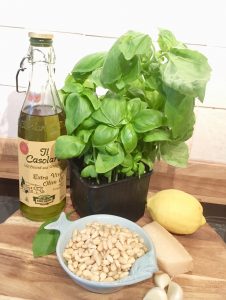
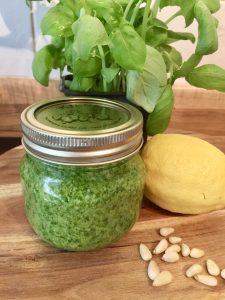
Here’s What I found.
Most of the jars of pesto I found on the shelves in my local supermarket were fairly well known brands. There were also the supermarket’s own brand jars in various guises, most of which, in my opinion, bear no resemblance whatsoever to the “classic” pesto, despite saying on the jar that it is classic.
The majority of these branded jars are quite pricey. Oddly enough, I always assumed that you paid for quality and if you paid that little bit extra, you got a better quality of product. sadly that doesn’t seem to be the case. Here are a few of the pestos I found. I have tried to be objective. I haven’t just chosen ones that I feel are bad. I have also included ones that are actually very close to what I feel pesto should actually be. The pictures, ingredients and blurb are taken, where possible, from the website of the company itself. Failing that, they are taken from a mail order food website but I have stated where the information has come from and where possible included a link. And please remember. These are entirely my own views.
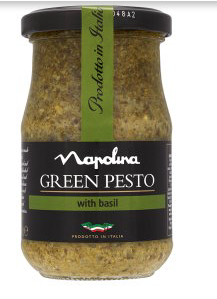
What the blurb says – (Taken from their website) Classic green pesto made with garlic, fragrant basil and pine nuts, blended with olive oil and Pecorino cheese for a classic Italian flavour.
What’s in the jar – (Taken from a supermarket website) Basil (40%), Sunflower Oil, Water, Cashew Nuts, Hard Cheese, ((Milk), preservative:Lysozyme (egg)), Glucose Syrup, Pecorino Cheese (3.4%), (Milk), Potato Flakes, Salt, Extra Virgin Olive Oil (1.2%), Acidity Regulator: Lactic acid, Pine Nuts (0.5%), Garlic.
Price Varies between £2.20 – £2.60 per jar. (although there was 25% off at the time I was doing my research making the cost actually £1.65)
As far as I’m concerned, Pesto, made with mostly sunflower oil, cashew nuts and “hard cheese” isn’t pesto. I also have to question why they feel the need to put potato flakes into the pesto. I am assuming it’s for the starch content to make the pesto thicker. Unfortunately, despite emailing several companies, I have yet to hear back from them so I can’t actually tell you why.
It also strikes me that the percentages of ingredients like pecorino cheese, extra virgin olive oil and pine nuts is actually very small. In fact, what the blurb should be saying is in fact – Pesto made with Sunflower Oil, Cashew Nuts and Hard Cheese. In my opinion it would be a much more honest description but then, of course, no one in their right mind would buy it!
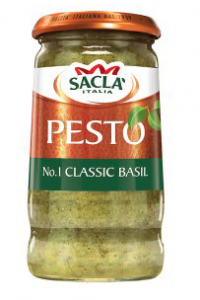
What the blurb says – (Taken from their website) The fresh, fragrant Italian basil is the hero of this classic recipe. It’s grown in the coastal region near Liguria, where the warm sunshine and moist sea breeze give the leaves an unmistakable perfume and intense flavour (it’s almost impossible to find basil quite like it anywhere else). To create our Pesto, we’ve pounded the basil leaves with Grana Padano cheese, Pecorino Romano cheese and pine nuts.
What’s in the jar – (taken from a supermarket website) Sunflower Seed Oil, Italian Basil (36%), Cashew Nuts, Grana Padano PDO Cheese (milk, egg), Sea salt, Glucose, Pecorino Romano PDO Cheese,(milk), Crushed pine kernels, Extra Virgin Olive Oil, Flavourings, Potato Flakes, Acidity Regulator: Lactic Acid.
Price – Varies between £2.50 and £3.40.
Once again, nowhere in the blurb is it mentioned that cashew nuts make up the majority of the nuts in this pesto. Nor the fact that sunflower seed oil is the main ingredient and not extra virgin olive oil.
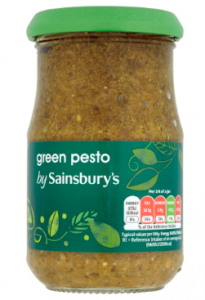
What the blurb says – (from their website) A pesto sauce of basil, cheeses, cashew nuts and pine nuts.
What’s in the jar – Basil (49%), Sunflower Oil, Pecorino Romano Cheese (Sheep’s Milk) (4.5%), Water, Grana Padano Cheese (Cows’ Milk, Preservative: Lysozyme (Egg)) (3.5%), Cashew Nuts (3%), Vegetable Fibre, Salt, Extra Virgin Olive Oil, Pine Nuts (1%), Acidity Regulator: Lactic Acid; Sugar, Garlic Powder, Antioxidant: Ascorbic Acid.
Price – £1.00
This one at least has a good percentage of basil however, sunflower oil and cashew nuts are the other main ingredients with pine nuts only contributing 1%. I guess they are honest enough to state that in contains cashew nuts which, frankly, is more than most of the others do. And I have to wonder what the unspecified “vegetable fibre” actually is. I don’t know which is worse, knowing what it is is or not knowing.
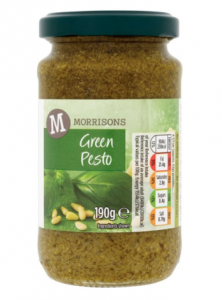
What the blurb says – Nothing, on the Morrissons shopping website there isn’t a blurb.
What’s in the jar – Basil (47%), Sunflower Oil, Grana Padano Cheese (6%) (Cheese (Milk), Preservative (Lysozyme (Egg))), Cashew Nuts, Potato Flakes (Potato, Emulsifier (Mono- and Diglycerides of Fatty Acids), Turmeric Extract), Water, Pecorino Romano Cheese (2%) (Sheep Milk), Salt, Extra Virgin Olive Oil, Pine Kernels (1%), Acidity Regulator (Lactic Acid), Garlic Powder, Flavouring
Price – Between £1 and £1.30 depending on it’s on promotion or not.
Honestly, I don’t actually know what to say about this. I have to confess, I have eaten this in the past. Before I started making my own pesto and before I realised what was actually in it. Not anymore. I have no idea what Mono and Diglycerides of fatty acids are but I am fairly sure that they shouldn’t be in Pesto, probably in any food at all and I am absolutely positive I don’t want to eat them.
There are, however a couple that, in my opinion are closer to the classic pesto than most.
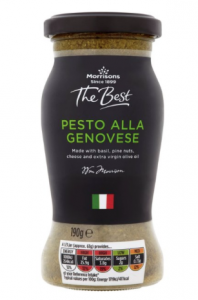
What the blurb says – (taken from the website) Made with basil, pine nuts, cheese and extra virgin olive oil.
What’s in the jar – Basil (38%), Extra Virgin Olive Oil (20%), Sunflower Oil, Parmigiano Reggiano Cheese (7%) (Milk), Pine Kernels (4%), Pecorino Romano Cheese (3%) (Sheeps Milk), Water, Sugar, Vegetable Fibre (Peas, Carrots), Salt, Acidity Regulator (Lactic Acid), Garlic Powder
Price – £2
In my opinion, apart from the peas, carrots and sunflower oil, it’s got everything in it that pesto should have. It actually tastes like pesto. The downside ……. as a result of the authentic pesto taste, it’s hardly ever available in my local Morrissons because it sells out so quickly.
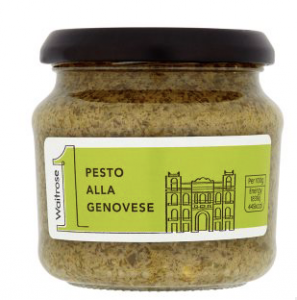
What the blurb says – (taken from the website) Italian inspired Basil, Parmigiano Reggiano and Pecorino Romano cheese pesto with extra virgin olive oil (37%)
What’s in the jar – Basil (44%), extra virgin olive oil (37%), Parmigiano Reggiano cheese (milk) (5%), Pecorino Romano cheese (milk) (5%), pine kernels, garlic, acidity regulator lactic acid, salt.
Price – £2.10
This pesto actually has nothing apart from the acidity regulator that shouldn’t be in there. In my opinion, this is how all pesto in a jar should be. Just authentic ingredients. If you can’t make your own, at least you can choose some that is as close to a classic pesto as possible.
So there you have it. What do you think? When do you think that pesto becomes so far removed from the real thing that it’s no longer pesto??